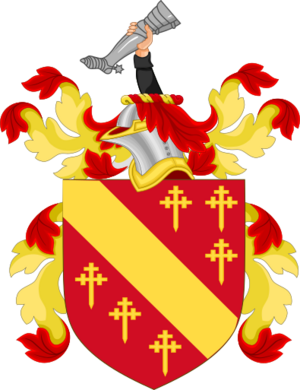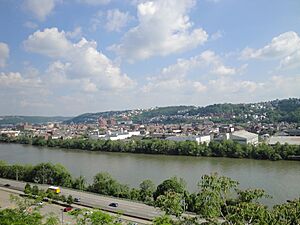John Ormsby (settler) facts for kids
Quick facts for kids
John Ormsby
|
|
|---|---|
| Born | 1720 Ireland
|
| Died | December 1805 |
| Resting place | Trinity Churchyard |
| Education | Trinity College, Dublin |
| Spouse(s) | Jane McAllister |
| Children | Oliver, Jane, Sarah, Mary, Sidney, and John |
| Parent(s) | Oliver Ormsby, Deborah Barry |
John Ormsby (1720–1805) was an important person in early American history. He was a soldier who fought in three major wars: the French and Indian War, Pontiac's Rebellion, and the American Revolution. He was also one of the very first settlers in Pittsburgh, Pennsylvania. John Ormsby came from a wealthy family in Ireland and moved to America in 1752. After Pontiac's Rebellion, he received a large piece of land from King George III. He built his home along the Monongahela River and became a successful businessman in the area.
Contents
John Ormsby's Early Life and Education
John Ormsby was born in Ireland in 1720. His parents were Oliver Ormsby and Deborah Barry. His family was well-known and had a large estate called Cloghan. John went to Trinity College in Dublin, which is a famous university.
After finishing his studies, John Ormsby moved to America. In 1753, he started a small teaching school in Philadelphia. The next year, he taught in other towns like Lancaster, York, Pennsylvania, and Alexandria, Virginia.
John Ormsby's Military Service
John Ormsby became a soldier during the French and Indian War. He was offered a high rank in the army of General Braddock. However, he got a serious illness, like malaria, which lasted for three years. Because of this, he could not join the army until 1758.
When he was well enough, he fought alongside famous leaders like John Forbes and George Washington. They worked together to capture Fort Duquesne from the French in 1758.
From 1759 to 1760, Ormsby helped build Fort Pitt. He was in charge of supplies and paying the soldiers. He even lived inside Fort Pitt in 1761.
Defending Fort Pitt During Pontiac's Rebellion
In 1763, during Pontiac's Rebellion, Native American tribes attacked many settlements. John Ormsby's property was destroyed, his horses were stolen, and some of his workers were killed. He later said that his house and store were destroyed by army orders. This was to stop the Native Americans from using them for shelter or supplies.
Ormsby helped defend Fort Pitt during the rebellion. The Native Americans surrounded the fort and cut off all supplies. John Ormsby wrote that the soldiers and people inside had almost no food. Luckily, English troops led by Henry Bouquet arrived with food and weapons. They defeated the Native Americans around Fort Pitt.
Land Grant and Settling Pittsburgh
After his military service, King George III gave John Ormsby a large piece of land in 1763. This land was about 3,000 acres (12 square kilometers) along the south side of the Monongahela River. Today, parts of this land are home to communities like South Side Flats, South Side Slopes, Mount Oliver, and Carrick.
The "Father" of Pittsburgh's South Side
In July 1764, John Ormsby married Jane McAllister. They first lived in Bedford, Pennsylvania, where Ormsby opened a trading store. They started their family on their farm there. But in 1770, they moved back to Pittsburgh. John Ormsby had a lot of land and business interests there.
His land stretched from what is now the Smithfield Street Bridge to Becks Run Road along the Monongahela River. He called this area Homestead Farms. In 1773, Ormsby got permission to run a ferry across the Monongahela River. This ferry connected Pittsburgh with his land on the South Side. It was the first ferry in Pittsburgh, and he ran it until 1789. He also started a brickyard and a boatyard near his home.
John Ormsby's daughter, Jane, married Dr. Nathaniel Bedford. In 1811, Dr. Bedford planned a town on the flat land on the south side of the river. He named it Birmingham. He honored John Ormsby by naming four streets after Ormsby's daughters: Jane, Sarah, Mary, and Sidney. This area is now known as the South Side.
John Ormsby's Death and Legacy
John Ormsby passed away in December 1805 in Allegheny County, Pennsylvania. He is buried at Trinity Churchyard in downtown Pittsburgh.
John Ormsby is remembered in Pittsburgh. Ormsby Avenue in Mount Oliver, Pennsylvania, is named after him and his family. Mount Oliver itself is named after his son, Oliver. There is also a baseball field on 22nd Street, off East Carson Street, that carries his name.




